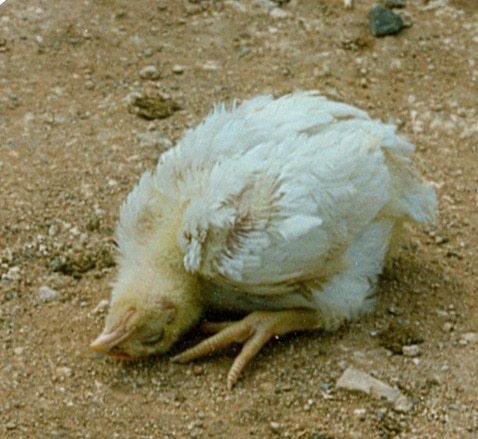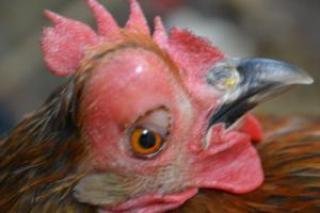14 Major Chicken Diseases, Symptoms, Prevention and Treatments

Raising chickens both on a commercial basis or in your backyard has immense benefits. However, major chicken diseases pose a great threat to the sustainability of this venture. Many give up their interest in poultry production due to the challenge of diseases.
Knowing about these major chicken diseases presents some ideas to prevent and better manage your chickens. So we bring you major chicken diseases, covering the symptoms and how to prevent and/or treat them.
1. Newcastle Disease

Cause: Newcastle disease is a contagious viral infection causing a respiratory nervous disorder in chickens and other birds. This disease is carried by other birds including wild birds. If you touch an infected bird you can pass it on from your clothes, shoes, and other items.
Symptoms: This disease also appears through the respiratory system. You will begin to see breathing problems, discharge from their nose, their eyes will begin to look murky. They also stop laying. The bird’s legs and wings become paralyse and their neck twisted.
Prevention and Treatment: Older birds usually recover and are not carriers afterwards. However, most baby birds will die from the disease.
2. Fowl Pox

Cause: The disease is caused a virus called by Avipox virus. The disease can be transmitted from virus carrier to other poultry through wounds or spread the virus even to a nearby poultry house.
Symptoms: Chickens develop white spots on their skin, scabby sores on their combs, white ulcers in their mouth or trachea. They also stop laying.
Prevention and Treatment: Feed them soft food and give them a warm and dry place to try and recoup. With adequate care, there is a great chance that your birds can survive this illness. There is a vaccine that can prevent the healthy birds from contracting the disease. Else, the disease can be spread by other contaminated birds, mosquitoes and can also be contracted from the air.
3. Quail disease
Cause: Clostridium colinum, a spore-forming bacterial rod is the cause of the disease. The infection spreads by the droppings from sick or carrier birds to healthy birds. The disease organism is very resistant to disinfectants and will persist under varying environmental conditions.
Symptoms: Birds with the acute form may die suddenly while in good flesh, whereas more chronically affected birds become listless, have ruffled feathers, whitish watery diarrhoea, and develop a humped-up posture. Infected birds usually die in an extremely emaciated condition.
Prevention and Treatment: Seek professional advice if you suspect infection. Bacitracin and penicillin are the most effective drugs in the treatment and prevention of this disease. If bacitracin is used, incorporate in the feed at levels up to 200 grams per ton of feed. Addition of bacitracin to the water at the rate of one teaspoon per gallon aids in controlling an outbreak of the disease. Either method of administering bacitracin will control the disease within two weeks unless a bacitracin-resistant strain of the disease organism is present. Penicillin is also used to treat the disease if bacitracin is not effective.
Raising birds on a wire is an effective preventative measure.
4. Botulism

Cause: It is a disease caused by the ingestion of a toxin produced by the Clostridium botulinum bacterium. All domestic fowl and most wild birds are susceptible to the toxin’s effects. If your chickens have contracted this disease it means that there has been some type of dead meat left near their food and water which contaminated it.
Symptoms: Chickens begin to have progressing tremors. The tremors will progress into total body paralysis which includes their breathing. You will also notice their feathers will be easy to pull out and death usually occurs within a few hours.
Prevention and Treatment: There is an antitoxin that can be acquired from a vet. If you notice the disease early enough you can mix 1 teaspoon of Epsom salts with 30mils of warm water. Administer to the birds by dropper once daily. This disease is avoidable as long as you keep your chickens in a clean environment and clean up any dead carcass from around their environment.
5. Fowl Cholera

Cause: The causative organism of fowl cholera is Pasteurella multocida. Fowl Cholera can be contracted from wild animals or food and water that has been contaminated by this bacteria.
Symptoms: Birds begin to have a greenish or yellowish diarrhoea and obvious joint pain. They also struggle to breathe and have a darkened head or wattle.
Prevention and Treatment: There is no real treatment. If by some chance your chicken survives, it will still always be a carrier of the disease. So it is usually better to put them down and destroy their carcass to prevent the spread. There is a vaccine, however, for your chickens to prevent the disease.
6. Infectious Bronchitis

Cause: The disease is caused by avian infectious bronchitis virus (IBV).
Symptoms: Chickens begin sneezing, snoring, and coughing. And then the drainage will begin to secrete from their nose and eyes. Laying will cease too.
Prevention and Treatment: You can get a vaccine to stop this disease from impacting your chickens. However, if you decide not to use a vaccine, quarantine as soon as you notice symptoms of the disease. Infectious Bronchitis is a viral disease and will travel quickly through the air. To treat Infectious Bronchitis, give your chickens a warm, dry place to recoup. A warm herb tea and feeding with fresh herbs may help.
7. Infectious Coryza

Cause: The disease is caused by a bacterium known as Hemophilus gallinarum. Outbreaks usually result from the introduction of infected or carrier birds into a flock. It can also be contracted through contaminated water and contaminated surfaces.
Symptoms: Heads become swollen. Their eyes will literally swell shut and their combs will swell. Then a discharge will begin to flow from their eyes and noses. They will stop laying and will have moisture under their wings.
Prevention and Treatment: There is no vaccine to stop this disease, unfortunately. Once your chickens contract this disease they should be killed and buried or burnt. If not, they will remain a carrier of the disease for life which is a risk to the rest of your flock.
Keep your chickens protected from other random chickens and keep their coop and water clean to prevent the disease.
8. Marek’s Disease

Cause: Marek’s disease is caused by a virus belonging to the Herpes virus group. They actually obtain the virus by breathing in pieces of shed skin and feather from an infected chick. This disease is very easy for them to catch.
Symptoms: More common in younger birds that are usually under the age of 20 weeks. Tumours begin to grow inside or outside of your chick. Their iris turns grey and they no longer respond to light. They become paralyzed.
Prevention and Treatment: If your chick gets this disease it needs to be put down. It will remain a carrier of the disease for life if it survives. However, you can give a vaccine to day-old chicks to prevent the disease.
9. Thrush

Cause: It is a fungal disease caused by the yeast Candida albicans.
Symptoms: A white oozy substance inside their crop. The chicken will appear lethargic and have a crusty vent area. And their feathers will look ruffled.It is important to mention that thrush is a fungal disease. This means it can be contracted if you allow your chickens to eat moulded feed or other moulded food. And they can also contract the disease from contaminated water or surfaces.
Prevention and Treatment: Though there is no vaccine, it can be treated by an anti-fungal medicine that you can get from your local vet. Be sure to remove the bad food and clean their water container as well.
10. Bumblefoot

Cause: This disease is acquired the chicken wound on the foot gets infected. The chicken may accidentally cut its foot on something; when digging in the garden, scratching around in mulch, and so many other ways.
Symptoms: This infected wound swells up the leg.
Prevention and Treatment: Bumblefoot can happen very easily and it is not much you can do to prevent besides just keep a close eye on your chickens’ feet. If you find out a cut on the foot, wash and disinfect it to prevent the disease from setting up.
11. Air Sac Disease
Cause: It is caused by an organism called Mycoplasma gallisepticum.
Symptoms: Disease starts with poor laying and a weak chicken. As it progresses, coughing, sneezing, breathing problems, swollen joints, and possibly death.
Prevention and Treatment: There is a vaccine for the illness. It can also be treated with an antibiotic from the vet. It can spread from bird to bird so keep an eye out for any of these symptoms so it can be treated quickly and effectively..
12. Mushy Chick

Cause: It is a bacterial infection due to improper closure of the navel. It can usually be traced to faulty incubation, poor hatchery sanitation or chilling/overheating soon after hatching.
Symptoms: Usually, this disease shows up in newly hatched chicks that have a midsection that is enlarged, inflamed, and blue tinted. The chick will have an unpleasant scent and will appear to be drowsy. Naturally, the chick will also be weak.
Prevention and Treatment: There is no vaccine for this disease but sometimes antibiotics may work. It usually is transmitted from chick to chick or from a dirty surface where an infected chick was. Usually, it is contracted from an unclean area where a chick with a weak immune system contracts the bacteria. The best practice is to separate the birds from the sick ones in the case of the disease incidence.
13. Pullorum

Cause: The cause is a bacterium named Salmonella pullorum. This organism is primarily egg transmitted, but transmission may occur by other means. It can be contracted through contaminated surfaces and other birds that have become carriers of the disease.
Symptoms: The effect of the disease on chicks and older birds are different. The chicks show no sign of activity and have a white paste all over their backsides and also show signs of breathing difficulty. Some will die with no signs at all. In older birds, however, you will see sneezing and coughing beside poor laying.
Prevention and Treatment: There is no vaccine for this disease. All birds that contract the disease should be put down and the carcass burnt or buried so no other animal will pick up the disease.
14. Avian Influenza

Cause: Also known as the bird flu, It was one of my initial fears of owning chickens because all you hear about on the news is how people get sick with bird flu from their chickens. However, after knowing the symptoms you’ll be able to put that fear to rest.
You need to know how to act quickly if you are afraid your backyard birds have come in contact with it.
Symptoms: The signs include respiratory troubles and birds will stop laying. They develop diarrhoea. There may be swelling in the chicken’s face and that their comb and wattle discoloured or turned blue. They may even develop dark red spots on their legs and combs.
Prevention and Treatment: There is no vaccine and the chickens infected will always be carriers. Wild animals can even carry the disease from bird to bird. Once your birds get this disease, they need to be put down and the carcass burnt or buried. You need to sanitize all areas that the birds were, before introducing a new flock. Take great caution because this disease can make humans sick.
Credit: Agrihome Expression (https://agrihomegh.com)






It great hear from u I have problem in my chicken there are lossiñg weight everyday sàme dead I need help
Have been really helped thank so much
My chickens die the skin is blue and they lay down on the floor heads flat on the ground and veet parted